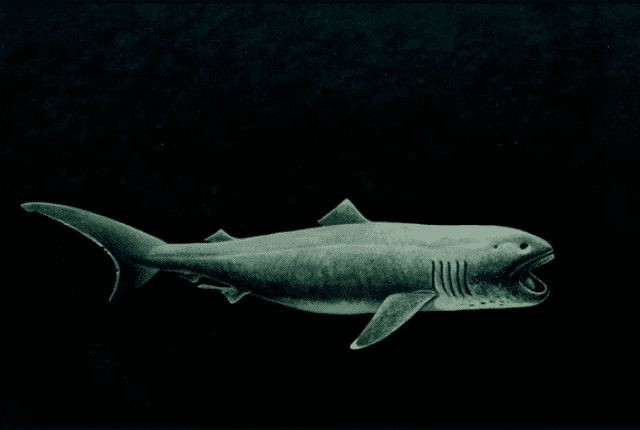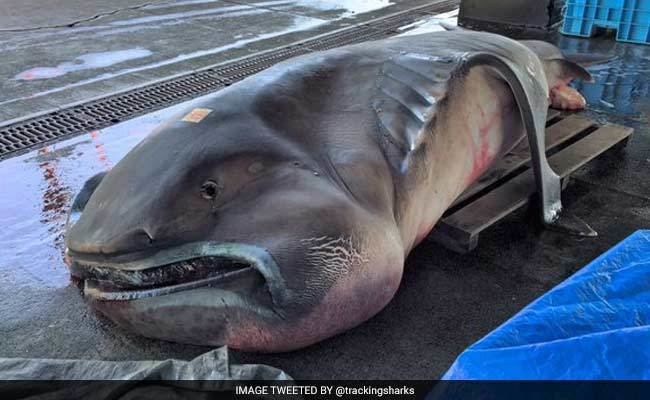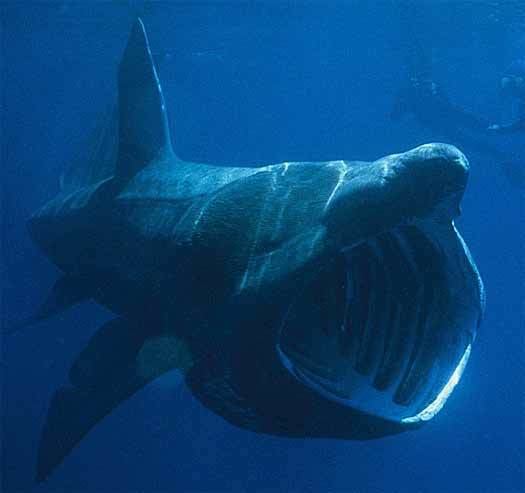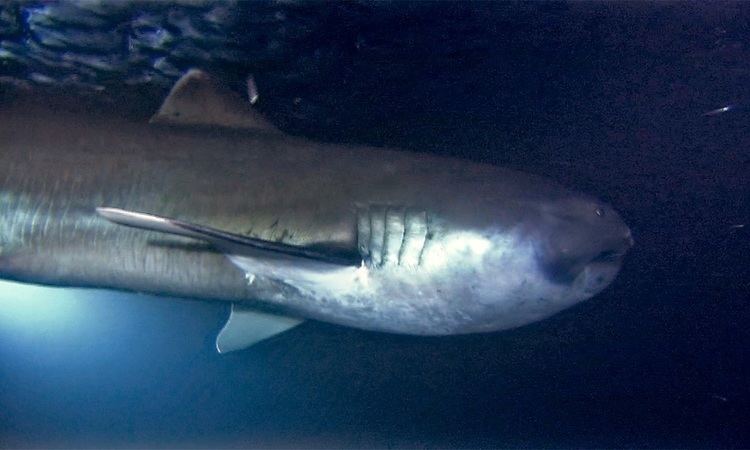Subclass Elasmobranchii Higher classification Megachasma | Phylum Chordata Superorder Selachimorpha Scientific name Megachasma pelagios Rank Species | |
Similar Shark, Basking shark, Frilled shark, Goblin shark, Megalodon | ||
Rare megamouth shark
The megamouth shark (Megachasma pelagios) is a species of deepwater shark. It is rarely seen by humans and is the smallest of the three extant planktivorous sharks, besides the whale shark and basking shark. Since its discovery in 1976, few megamouth sharks have been seen, with 61 specimens known to have been caught or sighted as of April 2015, including three recordings on film. Like the other two filter-feeders, it swims with its enormous mouth wide open, filtering water for plankton and jellyfish. It is distinctive for its large head with rubbery lips. It is so unlike any other type of shark that it is usually considered to be the sole extant species in the distinct family Megachasmidae, though suggestion has been made that it may belong in the family Cetorhinidae, of which the basking shark is currently the sole extant member. In addition to the living M. pelagios, however, two extinct megamouth species – the Priabonian M. alisonae and the Oligocene–Miocene M. applegatei – have also recently been proposed on the basis of fossilized tooth remains. However, the Cretaceous-aged M. comanchensis has been recently reclassified as an odontaspid shark in the genus Pseudomegachasma, and is in fact unrelated to the megamouth shark despite similar teeth morphology.
Contents

Description

The appearance of the megamouth is distinctive, but little else is known about it. It has a brownish-black colour on top, is white underneath, and has an asymmetrical tail with a long upper lobe, similar to that of the thresher shark. The interior of its gill slits are lined with finger-like gill rakers that capture its food. A relatively poor swimmer, the megamouth has a soft, flabby body and lacks caudal keels. The megamouth is considerably less active than the other filter-feeding sharks, the basking shark and the whale shark. The megamouth has a stout body and a long, wide bulbous head.

Megamouths are large sharks, able to grow to 5.5 metres (18 ft) in length. Males mature by 4 m (13 ft) and females by 5 m (16 ft). Weights of up to 1,215 kg (2,679 lb) have been reported.

As their name implies, megamouths have a large mouth with small teeth, and a broad, rounded snout, causing observers to occasionally mistake megamouth for a young orca. The mouth is surrounded by luminous photophores, which may act as a lure for plankton or small fish. This white band is present in both sexes and is thought to be used as a means of identification to other megamouth sharks. Their mouths can reach up to 1.3 m (4 ft 3 in) wide.
Behavior

In 1990, a 4.9-m (16-foot) male megamouth shark was caught near the surface off Dana Point, California. This individual was eventually released with a small radio tag attached to its soft body. The tag relayed depth and time information over a two-day period. During the day, the shark swam at a depth of around 120–160 m (390–520 ft), but as the sun set, it would ascend and spend the night at depths of between 12 and 25 m (39 and 82 ft). Both day and night, its progress was very slow at around 1.5–2.1 km/h (0.93–1.30 mph). This pattern of vertical migration is seen in many marine animals as they track the movement of plankton in the water column. The shark captured in March 2009 was reportedly netted at a depth of 200 m (660 ft).
Reproduction
Reproduction is ovoviviparous, meaning that the young sharks develop in eggs that remain within the mother's body until they hatch.
Discovery
The first megamouth was captured on November 15, 1976 about 25 miles off the coast of Kāneʻohe, Hawaiʻi, when it became entangled in the sea anchor of United States Navy ship AFB-14. Examination of the 4.5-m (14.7-ft), 750-kg (1,650-lb) specimen by Leighton Taylor showed it to be an entirely unknown type of shark, making it – along with the coelacanth – one of the more sensational discoveries in 20th-century ichthyology.
Known specimens
As of January 2015, only 61 megamouth specimens have been caught or sighted, the most recent being one found in the Philippines. They have been found in the Pacific, Atlantic and Indian oceans. Japan, the Philippines, Vietnam, and Taiwan have each yielded at least 10 specimens, the most of any single area, amounting to more than half the worldwide total. Specimens have also been sighted in or come out of the waters near Hawaii, California, Mexico, Indonesia, Australia, Brazil, Senegal, South Africa and Ecuador.
On March 30, 2009 off Burias Island in the Philippines, an 880- to 1,100-pound (400- to 500-kilogram) 4-metre (13-foot) megamouth shark died while struggling in a fisherman's net and was subsequently taken to nearby Donsol in Sorsogon province, where it was examined by scientists, before being butchered and sold.
On 12 June 2011, a 3-m (10-ft) dead juvenile male was found by fishermen near the western Baja California Peninsula coast, in Sebastián Vizcaíno Bay. It was picked up by the same fishing vessel that in 2006 captured another megamouth specimen in Sebastián Vizcaíno Bay, which has led Mexican scientists to believe that the megamouth could be a seasonal visitor to the Baja California Peninsula. The new specimen was taken to Ensenada, where it was photographed and sliced in order for Scripps Institution of Oceanography and Mexican researchers to study the structure of its muscles and gills.
On May 7, 2014 a 4 m (13 ft) 680 kg (1,500 lb) female shark was captured at a depth of 800 metres (2,600 ft) off the coast of Shizuoka, Japan. The body was dissected in front of the public, by staff at the Marine Science Museum in Shizuoka City, Japan.
On June 30, 2014 a 500 kg (1,100 lb) female shark was captured in the shallow waters of Cagayan de Oro in the Philippines. Samples were sent to the Bureau of Fisheries and Aquatic Resources in northern Mindanao (BFAR-10) and the outer skin, mounted along with the jaw, is on display at the D' Bone Collector Museum in Davao.
On January 28, 2015 a 4.5 m (15 ft) deceased megamouth shark was found by residents of Barangay Marigondon, in Pioduran town, Albay, Philippines. It is now on display at the Albay Parks and Wildlife, opened to the public since March 3, 2015 which coincided with Albay's celebration of the World Wildlife Day. The megamouth shark was preserved through taxidermy, and is now considered one of the more precious collections of Albay, a leading province in environment protection.
On April 14, 2016 a 5 m (16 ft) deceased megamouth shark was caught in a fisherman's net in Mie Prefecture, of the Japanese island of Honshu around three miles off the Owase Port. The shark weighed an estimated 907 kg (2,000 lb)
